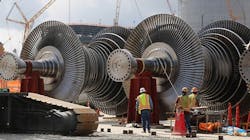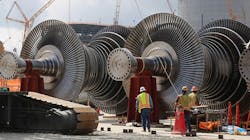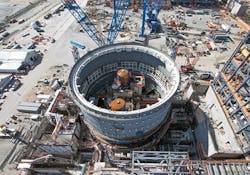Following a prolonged gestation period for the April delivery of the last in-progress U.S. nuclear power project, electricity from atoms could be heading toward a new birthing cycle.
Brand new technological approaches to generating nuclear power are gaining traction alongside surging interest in restarting retired nuclear plants, dusting off mothballed plans and transforming shuttered coal-fired generating plant sites. The moves reflect a growing belief that nuclear must play a central role in moving the country toward carbon-free power generation.
Setting the stage, yesterday’s nuclear power era may have officially ended earlier this year. The fourth and final planned reactor at Georgia Power’s Plant Vogtle nuclear complex near Waynesboro, Ga., the only one of 24 nuclear projects underway in 2009 brought to completion, came online in the spring. The 1,114MW Unit 4 took 14 years to complete as it and Unit 3, which came online in 2023, ran into delays and cost overruns that put the final price tag at $30 billion, more than double the original estimate for the two reactor projects. With four reactors, including two that came online in the late 1980s, Plant Vogtle is the nation’s largest nuclear generating station, with a 5-GW capacity.
Like all the nuclear projects that preceded it, Vogtle was a construction behemoth. At its peak, 9,000 construction workers were on site, Georgia Power says. Unionized electrical workers, members of the International Brotherhood of Electrical Workers (IBEW), totaled around 1,800 at that peak, according to IBEW, Georgia Power says more than 7-million linear feet of cable were laid, along with 1.3 million linear feet of conduit.
That massive scale — and what it implies — is part of what could haunt any would-be developer of new nuclear projects. Labor needs over an extended period would be critical, and expected construction worker shortages amplify that concern. Specialized design, engineering, and construction expertise essential for such projects might also be expected to be in short supply given the long hiatus in nuclear power plant construction, save the Vogtle plant. And presumed insistence on zero-tolerance for accidents in any large-scale restart of nuclear would likely add more layers of complexity, delay, and cost overruns to reactor construction. That prospect is laid out in a recent Institute for Progress paper in which infrastructure expert Brian Potter maintains that “[l]ong periods spent without construction of new plants also mean the nuclear supply chain withers, and workers’ and companies’ experience building nuclear plants is lost. Without companies with experience in building nuclear plants, new plant construction will inevitably be slower and costlier as competencies are re-acquired. Building nuclear plants cost effectively requires developing and maintaining an experienced nuclear workforce.”
Yet the demand for power — and the cleaner the better — is stoking the nuclear buildout buzz. A new U.S. Department of Energy analysis suggests additional reactors could be built on some 40 operating or retired nuclear sites, delivering up to 95 GW of new generating capacity. More could be added at sites where projects weren’t built but have some licensing in the bank. The report said many sites could host large light-water reactors, the reigning technology, and other next-generation-technology reactors that are drawing more interest.
Research into new reactor designs got a boost in October. DOE called for applications for $900 million in DOE grants to help deploy small modular reactor technologies. SMRs are being touted for their comparative flexibility, constructability, lower costs, and safety, attributes that could help speed up more nuclear power deployment. Designed to be built remotely and then delivered to the site, SMRs would represent a sea change in how nuclear power is delivered.
Another DOE focus is new reactor technologies. It has already funded two Advanced Reactor Demonstration Projects with $2.5 billion in Bipartisan Infrastructure Law monies. One is being built by TerraPower near a retired coal plant in Wyoming. It utilizes a revolutionary sodium-cooled fast reactor design that could integrate well into a renewable power heavy grid. The other is being built for an industrial site on the Gulf Coast by x-Energy. It will utilize a high-temperature, gas-cooled reactor technology that could meet industrial process heating needs more efficiently than carbon-producing energy sources.
Whatever nuclear power technologies and designs eventually emerge from the experimentation currently ramping up, a new round of U.S. nuclear power capacity build-out seems all but assured. Meeting a 2050 zero-emissions goal for the nation, DOE has said, will require 700 GW to 900 GW of additional clean, firm power capacity, a large share of which will almost certainly have to come from nuclear. And that will mean more reactors; new ones built on site from the ground up or produced in a factory; existing ones retooled, refurbished and restarted. The common denominator: Construction expertise will be indispensable. Firms that know how to navigate that highly specialized market, and have the foresight to plan for it, are likely to reap rewards.
About the Author
Tom Zind
Freelance Writer
Zind is a freelance writer based in Lee’s Summit, Mo. He can be reached at [email protected].


